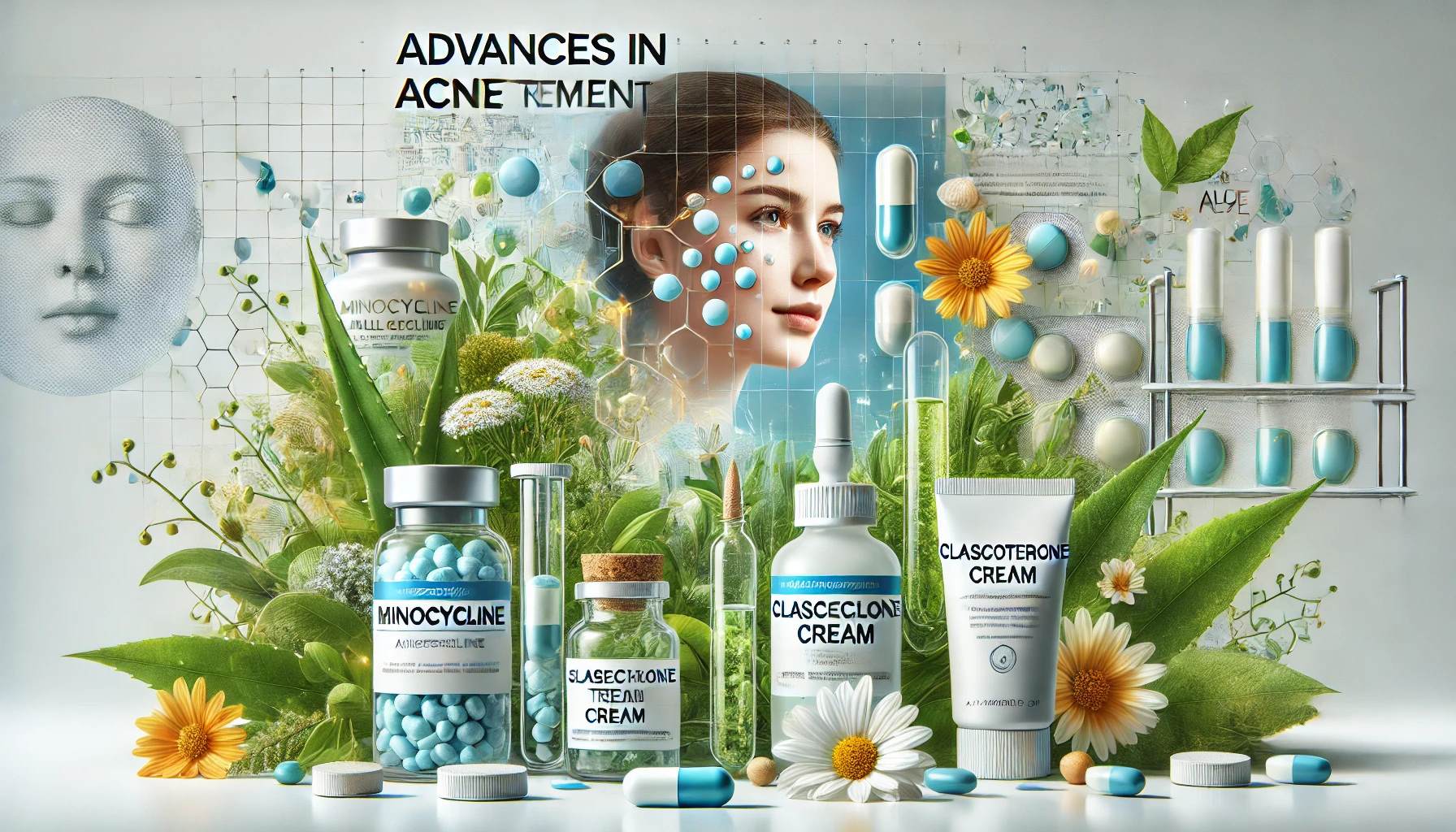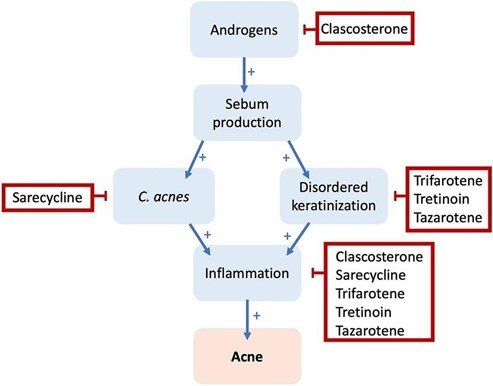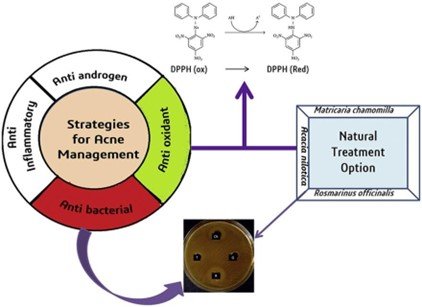
Acne is primarily a metabolic disorder concerning the pilosebaceous appendage, where hormones, microorganisms, fatty acids, and inflammatory cells aggravate the pathogenic process. Oral antibiotics have been a class of well-documented drugs effective in treating acne. On the other hand, the numerous side effects cannot be overlooked. In order to strike a balance between effectiveness and side-effect reduction, a continuous line of research continues to find optimal acne remedies, a disease that affects millions globally. The essay highlights the usage of different synthetic drugs like minocycline, Sarecycline, and topical clascoterone, all of which belong to the class of tetracycline that is commonly used for treatment. Additionally, the essay also sheds light upon advances in acne treatment through the utilization of plant extracts
Thesis statement
Latest developments in acne medication focus more upon topical usage of the drug. This not only becomes beneficial in terms of usage but also optimally reduces common side effects like dryness, photosensitivity, and itchiness.
Acne treatment through Minocycline
Minocycline has been proven to be effective in treating Acne Vulgaris in moderate to severe form and is commercially manufactured as a foam. The drug belongs to the semi-synthetic derived tetracycline group possessing anti-inflammatory activity, antibiotic activity, ability to suppress neutrophil chemotaxis, downregulate cytokine production and inhibit phagocytosis (Martins et al. 2021). The study executed by Gold et al. (2019) involved a randomized trial using Minocycline in the form of 4% FMX101. 466 subjects were subjected to the drug-using minocycline with foam being a vehicle, and the rest 495 were administered the drug directly. Non-inflammatory lesions were reduced in both the trials, but the subjects using foam-based reported superior skin tolerance as well. Another study conducted by Bonati and Dover (2019), demonstrates similar effectiveness of the drug when administered as hydrophilic minocycline gel and lipophilic minocycline foam. Contradicting the previous study, Bonati and Dover (2019), emphasize the superior effectiveness of Minocycline as a hydrophilic gel, rather than foam. FMX101 4% also displays efficacy in spontaneous resistance to Propionibacterium acnes having frequencies of 5*10-9 to 1 *10-8 (Sutcliffe, 2020). Moreover, the drug has been demonstrated to
be effective even after 15 passages, therefore providing no advantage for Minocycline-resistant mutant species of P. acnes.
Acne treatment using Sarecycline
Several acne treatments are present that effectively treat the incidence and occurrence, whereas the challenge lies in the reduction of the associated side effects like photosensitivity, dryness, and irritation. Sarecycline belongs to the tetracycline class of antibiotic medicines that bear an anti-inflammatory effect in reducing acne (Moore et al. 2019). The narrow spectrum of action in Sarecycline emphasizes a narrow scope of activity on host-microbiome consisting of Enterobacteriaceae Enterococci and other anaerobes in comparison to comparative tetracyclines. Sarecycline elicits its anti-microbial action through targeting and consecutively inhibiting the process of protein synthesis in microbes present (Zhanel et al. 2019). Specifically microbial, DNA, protein RNA, cell wall, and lipid synthesis is targeted and inhibited by the drug. 51.8% in the randomized trials reported a reduction in lesion count as early in 3rd week of drug administration (Han et al. 2021). Owing to the narrow antibacterial activity spectrum, it bears the potential to become an alternative to traditionally used tetracycline, along with less risk of antibiotic resistance. The cost of the drug is high hindering their commercialization

Figure 1: Acne pathogenesis (red) and treatment mechanism (blue) using Sarecycline
(Source: Han et al. 2021)
Acne treatment through Topical clascoterone
1% clascoterone cream has been identified as a trailblazer androgen receptor that topically targets and treats acne. The drug has received official recognition on 27th August 2020 from FDA to be commercially manufactured and used on patients above the age of 12. A two-phased randomized trial has been conducted by Hebert et al. (2020) using 1% clascoterone cream for facial acne, involving over 1440 patients. As a result, there has been an absolute reduction in inflation and reduction of lesion count. Spironolactone has been an oral androgen-based acne treatment present in the market for a long time having systemic side effects, on the other hand, clascoterone has fewer side effects being topical (Piszczatoski and Powell, 2021). Even though the mechanism of action has not yet been fully studied, it is believed to compete with androgen dihydrotestosterone to bind with androgen receptors, present in sebaceous glands, attenuating the acne pathogenesis signalling pathway.
Acne treatment through plant extracts
In addition to internal and external factors leading to the development of chronic skin infection of acne, Acne vulgaris bacteria are also involved. The study conducted by Vora et al. (2018), screens a wide array of plant extracts in order to evaluate the effectiveness of different potential plant extracts using the agar method and diffusion method. According to the results obtained, Rosmarinus officinalis, Acacia nilotica, and Matricaria chamomilla displayed effectiveness in reducing inflammation caused by P. acnes of varying diameters 4mm, 6 mm, and 8 mm respectively. The antioxidant assay was measured spectroscopically using diphenyl-2-picryl hydroxyl solution (DPPH). Minimum inhibitory concentrations displayed by the natural extracts are less over the identified bacteria causing acne. Additionally, being naturally extracted bears no side effects. In this regard, these extracts hold the potential to be formulated as solitary treatment or in combination to combat the disease. A similar study has been conducted by (Ali and Obaid, 2019), using acetone extracts of Matricaria chamomilla, Camellia sinensis, and Cassia acutifolia. The results displayed a high level of antibacterial susceptibility when M. chamomilla and C.sinensis is used in equal ratios.

Figure 2: Antioxidant assay of plant extracts using DPPH
(Source: Vora et al. 2018)
The essay highlights the latest development in the field of acne treatment using compounds that diverts the focus from oral to topical medicines in order to reduce the wide range of side effects through traditional acne medications. The drug minocycline displays effectiveness in the reduction of inflammation, but it requires a vehicle for optimal administration. Contradicting results have been obtained mentioning foam and hydrophilic gel being an optimal carrier of the drug. Sarecycline having a narrow spectrum of antibacterial activity combats the development of antibiotic resistance, in addition to reducing inflammation and inhibiting the microbe synthesis activities. clascoterone cream has been able to place itself in the commercial market, unlike Sarecycline based drugs, owing to their cost-effectiveness and novelty of being an androgen receptor-based acne treatment. Plant extracts hold the key to the holistic treatment of the disease, with different plant species like A. nilotica, M.chamomilla, and R. officinalis.
Ali, M.J. and Obaid, R.F., 2019. Antibacterial Activity for Acne Treatment through Medicinal Plants Extracts: Novel Alternative Therapies for Acne. J Pure Appl Microbiol, 13(2), pp.1245- 1250.
Bonati, L.M. and Dover, J.S., 2019. Treating acne with topical antibiotics: current obstacles and the introduction of topical minocycline as a new treatment option. Journal of Drugs in Dermatology: JDD, 18(3), pp.240-244.
Gold, L.S., Dhawan, S., Weiss, J., Draelos, Z.D., Ellman, H. and Stuart, I.A., 2019. A novel topical minocycline foam for the treatment of moderate-to-severe acne vulgaris: results of 2 randomized, double-blind, phase 3 studies. Journal of the American Academy of Dermatology, 80(1), pp.168-177.
Han, J.J., Faletsky, A., Barbieri, J.S. and Mostaghimi, A., 2021. New acne therapies and updates on use of spironolactone and isotretinoin: a narrative review. Dermatology and Therapy, 11(1), pp.79-91.
Hebert, A., Thiboutot, D., Gold, L.S., Cartwright, M., Gerloni, M., Fragasso, E. and Mazzetti, A., 2020. Efficacy and safety of topical clascoterone cream, 1%, for treatment in patients with facial acne: two phase 3 randomized clinical trials. JAMA dermatology, 156(6), pp.621-630.
Martins, A.M., Marto, J.M., Johnson, J.L. and Graber, E.M., 2021. A Review of Systemic Minocycline Side Effects and Topical Minocycline as a Safer Alternative for Treating Acne and Rosacea. Antibiotics, 10(7), p.757.
Moore, A.Y., Charles, J.E.M. and Moore, S., 2019. Sarecycline: a narrow spectrum tetracycline for the treatment of moderate-to-severe acne vulgaris. Future microbiology, 14(14), pp.1235- 1242.
Piszczatoski, C.R. and Powell, J., 2021. Topical Clascoterone: The First Novel Agent for Acne Vulgaris in 40 Years. Clinical therapeutics, 43(10), pp.1638-1644.
Sutcliffe, J., McLaughlin, R., Webster, G., Read, A.F., Drlica, K., Elliott, R. and Stuart, I., 2020. Susceptibility of Cutibacterium acnes to topical minocycline foam. Anaerobe, 62, p.102169.
Vora, J., Srivastava, A. and Modi, H., 2018. Antibacterial and antioxidant strategies for acne treatment through plant extracts. Informatics in Medicine unlocked, 13, pp.128-132.
Zhanel, G., Critchley, I., Lin, L.Y. and Alvandi, N., 2019. Microbiological profile of sarecycline, a novel targeted spectrum tetracycline for the treatment of acne vulgaris. Antimicrobial agents and chemotherapy, 63(1), pp.e01297-18.
